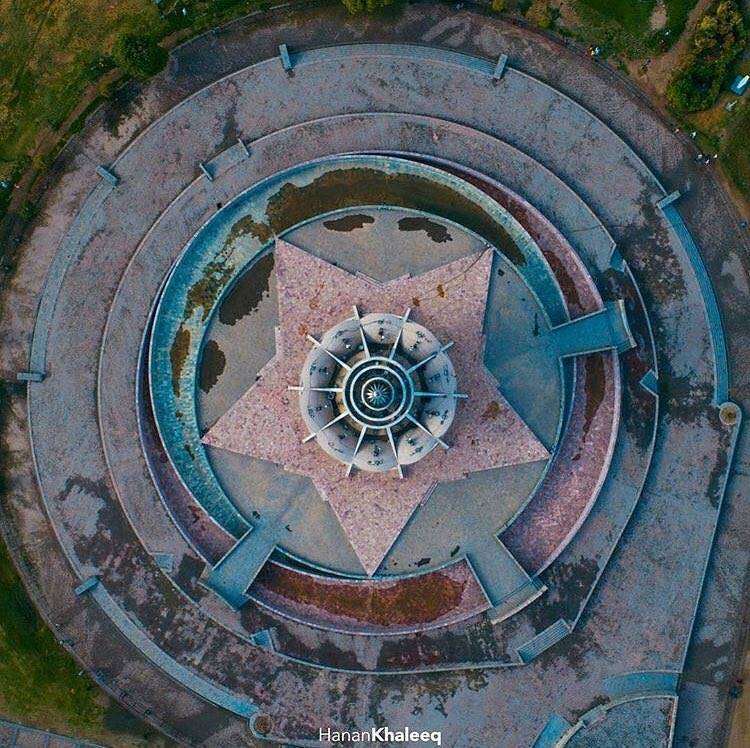Minar-e-Pakistan stands as a monumental symbol of Pakistan’s independence and a masterpiece of architectural brilliance. Located in Iqbal Park, Lahore, this towering structure marks the historic moment when the Pakistan Resolution was passed on March 23, 1940, setting the foundation for the creation of an independent state for Muslims in the subcontinent.
The Architectural Significance of Minar-e-Pakistan
Minar-e-Pakistan is not just a historical landmark; it embodies geometrical precision and deep symbolism. Recently, a renowned photographer, Muazaaml Husain Tori, captured an aerial view of the monument, revealing its hidden design mystery. The eagle-eye perspective showcases an intricate alignment of two crescents and a star, elements that mirror Pakistan’s national flag.
This discovery has sparked widespread fascination, as many had previously overlooked the mathematical elegance behind its structure.
Who Was Murat Khan – The Architect Behind Minar-e-Pakistan?
The genius mind behind Minar-e-Pakistan was Naseer Uddin Murat Khan, a Russian-born architect who later became a Pakistani national.

- Born in 1904, Murat Khan pursued Civil Engineering from Leningrad University.
- Due to his anti-Soviet stance, he sought asylum in Germany before moving to Pakistan in 1950 with his family.
- He contributed significantly to Pakistan’s urban landscape by designing residential and commercial structures across major cities like Lahore, Islamabad, Rawalpindi, Peshawar, and Gujranwala.
- He was instrumental in planning the WAPDA Residential Colony at Mangla Dam, Lahore, and Multan.
- His portfolio includes the construction of 1000-bed Nishtar Medical Hospital (Multan), a 500-bed Mental Hospital (Mansehra), and The Division Public High School (Faisalabad).
Minar-e-Pakistan’s Design – A Masterpiece of Symbolism
Murat Khan’s design vision for Minar-e-Pakistan went beyond just constructing a national monument; he aimed to create a symbol of Pakistan’s ideological foundation. The structure incorporates traditional Islamic, Mughal, and modern architecture elements, standing 70 meters (230 feet) tall.
Design Breakdown:
- Base Structure: The flower-shaped base represents the struggles and sacrifices of Muslims who fought for an independent homeland.
- Geometric Layout: The red and green crescents reflect the former East and West Pakistan.
- Islamic Calligraphy: The monument features Quranic verses, sayings of Quaid-e-Azam Muhammad Ali Jinnah, and Allama Iqbal’s poetry engraved on its walls.
- Star and Crescent: The foundation layout aligns with the Pakistani flag, reinforcing the spiritual and national essence of the country’s independence movement.
Murat Khan’s Unparalleled Contribution
Despite being a renowned architect, Murat Khan never charged a single penny for designing Minar-e-Pakistan. He considered it a gift to Pakistan, a country that gave him a new identity and home. His firm, Illeri H. N. Murat Khan and Associates, played a crucial role in documenting and preserving Pakistan’s architectural heritage.
Google and CAP’s Initiative to Preserve Minar-e-Pakistan’s History
In an effort to preserve and document the rich history of Minar-e-Pakistan, The Citizens Archive of Pakistan (CAP) collaborated with Google to compile digital records of the monument’s creation and significance. Through their efforts, valuable historical documents, photographs, and architectural blueprints have been archived for future generations
Minar-e-Pakistan is more than just a landmark; it is a symbol of Pakistan’s freedom, struggle, and unity. Murat Khan’s artistic ingenuity and patriotic dedication are forever enshrined in this towering masterpiece, inspiring millions who visit this historic site.


